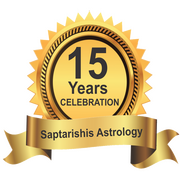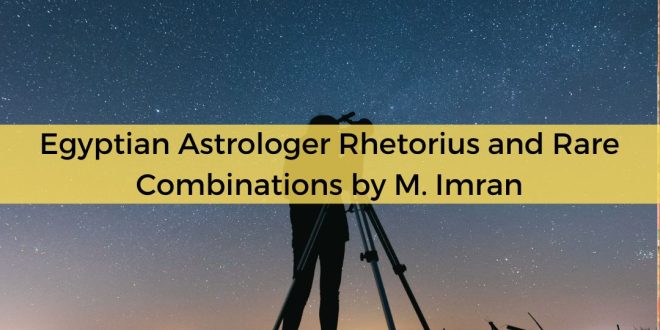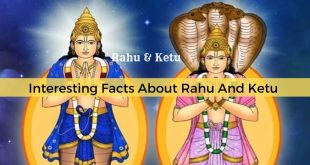Related Articles
Rhetorius the Egyptian was a noted classical astrologer of early Byzantine era, who enlightened us from the lost Treasuries of Antiochus. There exist varied claims about the time of Rhetorius. Famous scholar and translator James Holden in his ‘History of Horoscopic Astrology’ maintains that Rhetorius the Egyptian lived around 505 A.D. Late David Pingree dated Rhetorius to the early 7th century on the basis of a horoscope (February 24, 610 A.D.) found in section 110 of Compendium. However, in the preface of the modern English translation of the Compendium, James Holden refutes Pingree’s claim by stating that said horoscope is hypothetical and merely explains a certain principle. Whatever be the age of Rhetorius, the uncertainty about his time does not shorten the towering height of this genius astrologer.
The Compendium of Rhetorius is not only a rich source of late Roman and early Byzantine astrological thinking but also a compilation of the discourses of the earlier Hellenistic astrologers. Like his contemporaries, Rhetorius penned his Compendium in Greek despite he was not ethnically Greek. It comprises around 118 sections or articles. David Pingree first translated the Compendium into modern English, but could not publish it. Later James Holden rephrased and retranslated his earlier version of 1985. In 2005, under the aegis of American Federation of Astrologers (AFA), Holden’s translation publically appeared as Astrological Compendium Containing His Explanation and Narration of the Whole Art of Astrology.
The objective of this write-up is to highlight some unknown rather rare astrological combinations in Compendium, for, there are many pearls of astrological wisdom that is found nowhere else. Take for instance the section 82 to section 96 of Compendium that deals with various kinds of actions and pursuits, in other words, yogas pertaining to different professions.
1) Architects and Masons
Saturn in conjunction with Mars in Aries or Taurus or Leo, or being in square to Mars, or being aspected by Mars without any aspect from the natural benefic planets, makes roofers, or those who walk on walls, or architects, or potters, or lamp makers.
2) Carpenters and Artisans
If Saturn and Venus and Mars are aspecting each other in masculine signs, especially in Aries, Leo and Sagittarius, they indicate carpenters and tanners and those who cut leather into thongs. And, if Mercury is also in aspect, stone-masons, or quarrymen, or stone polishers are suggested. And if Jupiter and the Moon are in aspect, they make gem-engravers or marble workers.
3) Mechanics
Mercury, Mars, Venus, and Moon in angular (kendra) houses or aspecting each other from angles, make mechanics (those who work with devices or machines).
4) Tailors
Mars and Venus together or in square, in each other’s Terms make tailors, linen-weavers, and dealers in linen cloth.
5) Mimes and Conjurers
Mercury and Venus in their signs of fall, in their own Terms, or in those of each other, make mimes or public performers, especially in Capricorn. Mars and Mercury occupying the 4th house from ascendant show rope-walkers and conjurers. Mercury, Mars, Venus and Moon in cadent houses, and aspecting each other, make jugglers.
6) Musicians
Venus in the domicile of the Sun, or in its own domicile, with Mercury, especially in angular house produces reed-pipe players, guitarists, or musicians.
7) Seamen and Sailors
Saturn in 10th house or ascendant in watery sign (Cancer, Scorpio, Pisces), with Mars and Sun, or they are in aspect by square or opposition, yield sailors or steersmen or ship captains. The Moon when about to conjoin Saturn in descendant (7th house) in watery sign (Cancer, Scorpio, Pisces) also produces seamen.
8) Lame Genius
If Saturn and Mercury are in a domicile of Saturn and the Moon chances to be in Taurus, they make a wise orator, or a mathematician having very refined intellect. But it simultaneously causes rheumatism in the feet or in the ankles.
9) Astrologer or Diviners
If Mercury chances to be in a good house (i.e. in kendra or kona), and especially in a domicile of Saturn, without combustion, and aspected by Jupiter, Saturn and Mars, then this combination makes astrologers, diviners, or priests. And if Saturn chances to be in the ascendant in a domicile of Mercury, or if Mercury is in the ascendant, it implies an expert of astrological calculations.
10) Physicians
Mars and Venus being together or in square or opposition in their climes make physicians or learned philosopher. Mars and Mercury in the domiciles or Terms of Venus make physicians.
11) Falconers and Bird-feeders
If Mercury is not combust by Sun, and it is in conjunction with Moon, and they are aspecting each other’s Dodecatemories (dwadasamsas), and Mars and Saturn chance to be in opposition to each other in the angles, they make masters of the hounds and hunters. And if Mercury and the Moon chance to be in the winged signs (i.e. in Virgo and in Sagittarius) and in the first degrees of Pisces, they signify falconers or bird-feeders.
12) Bath Workers
If Saturn is aspecting the Moon, and Moon’s Dodecatemory (dwadasamsa) is in the Terms of Saturn then bath workers and bath attendants are born. But if they chance to be in cadent houses (3rd, 6th, 9th, 12th) or in the IC angle (4th house), it makes marble polishers.
13) Drunkard and Lewd Persons
Mars and Venus be in conjunction or in opposition, while their Dodecatemories (dwadasamsas) are without any strong aspect of the others then drunkards, armed robbers, adulterers, and exiles are the outcome. In addition, if Saturn (especially from feminine sign) also casts aspect upon (said Venus and Mars) then it shows lewd persons and lechers.
14) Killers and Criminals
Mars and Mercury in Leo in angular house, without aspect or association of Jupiter, Venus and the Sun, make fierce and cruel souls, characteristically those who are thinking about shedding blood for nothing, or cheats, perjurers, sacrilegious persons, forgers, and treacherous persons.
15) Removers of Corpse
Saturn in conjunction with Mars and Mercury, and all of them aspecting each other’s Dodecatemories (dwadasamsa), without any aspect from the benefics, make grave-diggers or removers of corpses or grave-robbers.
A Note on Dodecatemory and Term
Students and experts of Indian astrology are well aware of various type of vargas (divisional charts), and they presume that application of zodiac’s division is confined to Jyotish only. Some of the Indians mistakenly believe that western astrology does not weight and utilize divisional charts. But in reality, most of the classical western canons (especially ancient Greek, Hellenistic, and Medieval Persian astrological works) heavily rely on certain kind of divisional charts and their rulership.
Term, Decanate, Novenaria and Dodecatemory are off and on referred in delineation of the astrological combinations. Though, traditional westerns astrologers do not use to draw separate chart for these zodiacal divisions. They consider the ruler of the division, their nature, position, aspect and relationship in main birth chart.
Dodecatemory is identical to the Indian Dwadasamsa or the 12th division of a sign. It is also called Duodecima. Each segment of Dodecatemory consists of 2o30’ and there is no difference between ruler of Indian Dwadasamsa and western Dodecatemory.
Term (also called Bound or Limit) is the division of each zodiac sign into 5 unequal segments and ascribed to the 5 non-luminaries (i.e. Saturn, Jupiter, Mars, Venus and Mercury). Unlike navamsa, the span and lordship of Term does not follow zodiacal or any other order. In fact, the size of the Terms was actually based on how many degrees of the celestial equator rise with a given sign at the certain geographical place. These portions of celestial equator translated into zodiacal degrees, called Terms. Conventionally the Egyptian Terms are widely used and referred.
One of the interesting facts is that most of the Indian astrologers do use Term when dealing with varshphala (annual charts). However, in Jyotish and Tajik system of annual return, Term is known as Hadda.
Table of Terms or Hadda
Sign | 1st Term Range & Lord | 2nd Term Range & Lord | 3rd Term Range & Lord | 4th Term Range & Lord | 5th Term Range & Lord |
Ari → | 00 – 60 Jup | 60 – 130 Ven | 130 – 210 Mer | 210 – 250 Mar | 250 – 300 Sat |
Tau → | 00 – 80 Ven | 80 – 140 Mer | 140 – 220 Jup | 220 – 270 Sat | 270 – 300 Mar |
Gem → | 00 – 60 Mer | 06 – 120 Jup | 120 – 170 Ven | 170 – 240 Mar | 240 – 300 Sat |
Can → | 00 – 70 Mar | 70 – 130 Ven | 130 – 190 Mer | 190 – 260 Jup | 260 – 300 Sat |
Leo → | 00 – 60 Jup | 60 – 110 Ven | 110 – 180 Sat | 180 – 240 Mer | 240 – 300 Mar |
Vir → | 00 – 70 Mer | 70 – 170 Ven | 170 – 210 Jup | 210 – 280 Mars | 280 – 300 Sat |
Lib → | 00 – 60 Sat | 60 – 140 Mer | 140 – 210 Jup | 210 – 280 Ven | 280 – 300 Mar |
Sco → | 00 – 70 Mar | 70 – 110 Ven | 110 – 190 Mer | 190 – 240 Jup | 240 – 300 Sat |
Sag → | 00 – 120 Jup | 120 – 170 Ven | 170 – 210 Mer | 210 – 260 Sat | 260 – 300 Mar |
Cap → | 00 – 70 Mer | 70 – 140 Jup | 140 – 220 Ven | 220 – 260 Sat | 260 – 300 Mar |
Aqu → | 00 – 70 Mer | 70 – 130 Ven | 130 – 200 Jup | 200 – 250 Mar | 250 – 300 Sat |
Pis → | 00 – 120 Ven | 12 – 160 Jup | 160 – 190 Mer | 190 – 280 Mar | 280 – 300 Sat |
Learn Astrology: Join Our Upcoming Astrology Classes — Click Here
Learn Astrology: Join Our Recorded Astrology Classes — Click Here
 Saptarishis Astrology Magazine Into Creating Astrologers
Saptarishis Astrology Magazine Into Creating Astrologers






